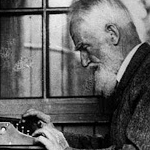A while ago, a friend invited several Shaw scholars – including me – to help him with a book he was putting together for a university press. Friday afternoon I went to the college library and picked up a book I needed to complete one last task for my contribution, a chapter about Bernard Shaw and education.
Of course I’m not really finished, even though I’ve already asked another Shaw scholar to critique my work. (He loved it!) I keep tinkering with what I’ve written, making tiny changes to sentences that have already been rewritten over and over.
It’s like something I’ve been told by friends who are famous for their culinary skills: When they sit down to eat a meal they’ve cooked for a dinner party, every bite is disappointing – even though their guests are raving about the food. I suspect it’s an unavoidable part of the creative process: The finished product never comes up to the glittering standard you were aiming for.
Still, it was fun to push my chapter over the finish line, and I’m happy with what I’ve done. I went into a drawer and pulled out notes I’d made along the way (some on the backs of baggage forms I’d picked up in an Amtrak station while we waited for a delayed train) to see if I’d missed anything important.
Happily, I hadn’t – but I came across a few quotations that were just too good to leave out, and that meant cutting elsewhere so that I could stick to my 3,000 word limit. That final stage in the writing process was fun, easy, and tidy.
But calling it a “writing process” sounds more formal and serious than it really is. I had gotten off to a messy and disorganized start (as I always do) a year ago by listing everything that absolutely, positively had to go into the chapter:
- a famous quotation that infuriates teachers (“He who can, does; he who cannot, teaches”)
- Shaw’s unhappy memories of his own schooldays
- a governess who taught him how to read
- his astoundingly successful program to educate himself
I also knew I’d be talking about Pygmalion (which later became My Fair Lady) – a play in which a half-educated flower girl learns how to speak and act like a lady.
And that was it. Do you see anything profound there? Or anything that a 21st-century educator would find interesting or inspiring? Or anything that could be expanded into 3,000 words?
I didn’t either.
The next thing I did was to purchase a 1958 book called Shaw on Education. It’s a well-researched and thoughtful book – but it’s also hopelessly out of date. I started reading and found the first two chapters astonishing. The British education system from Shaw’s time was totally different from what we have in the US today. I read those two chapters at least a dozen times because they provided such a good explanation of Shaw’s educational philosophy.
At that point a month had gone by, and I had no clue about how to put my chapter together. Shaw died in 1950. How was I going to make him relevant to today’s readers?
More in my next post!


